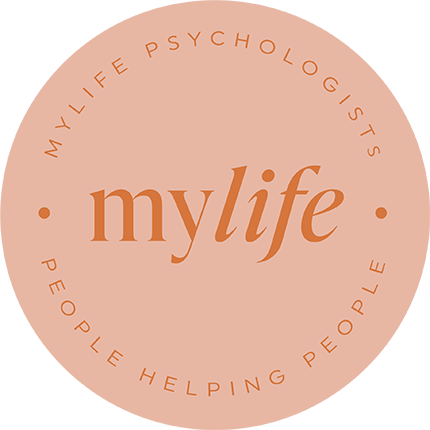Cognitive Behavioural Therapy (CBT)
Cognitive Behavioural Therapy (CBT) is a practical, evidence-based approach – and the gold standard treatment for many mental health concerns. It helps you break unhelpful patterns and build healthier ways of thinking and living to create lasting change.
At MyLife Psychologists, we offer Cognitive Behavioural Therapy (CBT) – an effective and research-supported psychological treatment designed to help you better understand the link between your thoughts, feelings and behaviours. CBT is widely regarded as the gold standard for treating a range of mental health concerns, including anxiety, depression, stress and insomnia.
Many of our clients come to us feeling overwhelmed, stuck in negative thinking, or caught in unhelpful patterns of behaviour. CBT provides a clear and structured path forward, helping you build insight, develop practical tools, and make meaningful changes that last.
What Is CBT?
Cognitive Behavioural Therapy (CBT) is a short to medium term, skills-based therapy that focuses on identifying and changing unhelpful patterns of thinking and behaviour. It’s based on the principle that how we interpret situations influences how we feel emotionally and how we respond.
Rather than dwelling on the past, CBT is present-focused and goal-oriented. You and your psychologist work together to better understand the difficulties you’re facing, develop strategies for change, and build resilience for the future. The approach is active, structured and empowering – designed to help you become more confident in managing challenges on your own.
How Does CBT Work?
CBT helps you uncover the patterns that may be keeping you stuck – such as automatic negative thoughts, rigid beliefs, and behaviours that offer short-term relief but maintain long-term distress. Your psychologist will support you to recognise these patterns, challenge unhelpful thinking, and learn healthier ways to respond.
Your psychologist will work with you to:
These insights are not just discussed in-session, but actively applied in your daily life through practical strategies and guided exercises. This process helps you break free from old habits, build confidence, and improve your overall wellbeing.
When Is CBT Useful?
CBT is highly effective for a range of mental health concerns. It is recommended in Australian clinical guidelines and international best-practice standards for treating many common conditions including anxiety (such as social anxiety, panic attacks, and generalised anxiety), depression, chronic stress and burnout, obsessive-compulsive symptoms, sleep difficulties, low self-esteem, and unhelpful perfectionism. CBT can also support recovery from traumatic experiences, manage anger more effectively, and assist with adjustment to life transitions or chronic health conditions.
Here are some of the challenges CBT is commonly used to treat:
Depression
CBT is one of the most effective and well-established treatments for depression. It helps people break the cycle of negative thinking, low mood, and reduced activity that often keeps depression going.
When you’re depressed, thoughts like “I’m a failure” or “Things will never improve” can feel true, even though they’re often distorted by low mood. CBT helps you identify these patterns and replace them with more balanced, realistic perspectives. Depression also tends to lead to withdrawal and inactivity, which can make symptoms worse. CBT uses techniques like behavioural activation to support re-engagement in everyday activities that can lift mood, such as:
With support from a clinical psychologist, CBT can help you improve motivation, rebuild confidence, and develop tools to prevent future setbacks – all at a pace that feels right for you.
Anxiety
CBT is considered the gold standard psychological treatment for anxiety. It helps you challenge unhelpful thoughts and reduce avoidance behaviours that keep anxiety alive. Through practical strategies and gradual exposure to feared situations, CBT builds your confidence and teaches you to manage anxiety more effectively.
It has strong evidence for helping with a range of anxiety-related conditions, including:
With support from a psychologist, you’ll learn to respond to anxiety in new, more helpful ways – so that fear no longer controls your life.
Eating Disorders
CBT is a proven, first-line treatment for eating disorders like bulimia and binge eating disorder. It helps by challenging unhelpful beliefs and supporting healthier eating patterns, helping you regain control and improve emotional wellbeing.
CBT can support you to:
With the support of a clinical psychologist, CBT can help you break free from unhelpful cycles and build a healthier, more compassionate relationship with food and your body.
Self-Esteem
CBT is an effective treatment for low self-esteem, helping you challenge and change the critical thoughts you hold about yourself. Over time, these negative beliefs can limit your confidence and hold you back from pursuing your goals.
By working with a clinical psychologist, you can gradually build a stronger, more positive sense of self that supports a fulfilling and engaged life.
Get Started with CBT in Sydney
Our team of clinical psychologists are highly trained in delivering CBT in a warm, respectful and compassionate manner. We take the time to understand your experiences and tailor therapy to your unique goals and preferences. Sessions are available both in person at our Sydney clinic and via secure telehealth.
If you’re feeling overwhelmed, anxious, stuck or unsure how to move forward, CBT can help you make sense of what’s going on and build practical strategies to feel better. You don’t have to go through it alone.
Get in touch with us today to find out more or to book your first session.

